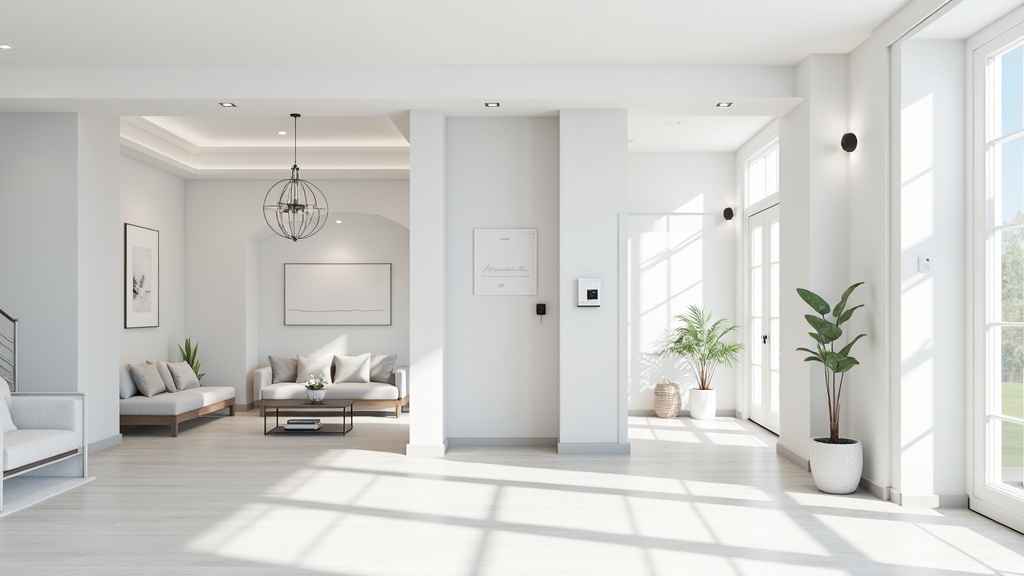Getting smart sensors set up in just the right spots around your home plays a pretty big part in taking your security system from decent to way more reliable. With the rise of smart technology, keeping your place secure has gone far beyond traditional alarms. These days, smart sensors can pick up on movement, break-ins, open or closed windows, and even things like leaks and smoke. The trick is getting the placement just right, because even the best sensor won’t help if it’s in the wrong spot. Here’s how to get the most out of smart sensors in your home security setup.

Why Sensor Placement Matters for Home Security
Putting your sensors in the right locations really affects how well your system works. A well-placed motion detector, entry sensor, or glass break sensor can give you a heads-up before anything bad happens. Place them poorly and you might as well not have a system at all. Sensors pick up movement, sound, or changes in status, so they work best where risk is higher or where access is easiest for intruders.
Statistics from the FBI show most break-ins happen through the front door, first-floor windows, or back doors. Understanding common entry points helps you figure out where to start when planning sensor placement. With more homes using smart devices, it’s worth knowing how to set everything up for full coverage while avoiding dead zones or constant false alarms from pets and regular activity.
Types of Smart Security Sensors and Their Roles
There’s a surprising range of smart sensors out there, so knowing the difference helps you plan. Here are the basics you’ll run into:
- Motion Sensors: Pick up on movement in a room or hallway using either passive infrared (PIR) or microwave sensors.
- Door/Window Entry Sensors: Tell you when a door or window opens or closes using a magnetic switch setup.
- Glass Break Sensors: Detect the sharp sound of glass shattering from a window or patio door.
- Environmental Sensors: Catch issues like water leaks, smoke, or carbon monoxide.
Each plays its own part in home security. Where you put each sensor depends on what you want to protect and the unique layout of your house.
Where to Place Security Sensors for the Best Protection
Finding the right spots is mostly about targeting the weak points in your home. Here are some ideas based on sensor type and the questions people ask most:
- Front and Back Doors: Entry sensors do their best work here. Mount them at the top or side where the door meets the frame so they can pick up when it opens or closes.
- Ground level Windows: Place entry sensors or glass break sensors on these, especially those hidden from street view or fenced-in areas. A small sensor in the top corner of each window often works best.
- Motion Sensors: These should go in main traffic areas like hallways leading from the front and back doors, foyers, or main living rooms. Placing a sensor high up in a corner facing the entrance covers the most ground.
- Garage Entry Points: Garages are a common way in for intruders. Add sensors to any service doors, and consider a motion sensor inside the garage for extra coverage.
- Basement Windows and Doors: Basements can be easy to forget. Put entry sensors on windows and any exterior doors leading underground.
- Second Floor or Balcony Access Points: If you have a balcony with a door or accessible windows, don’t skip them. Entry and glass break sensors keep even higher entry points safe.
The goal is to cover any place where someone could get in. For homes with pets, look for sensors that are pet friendly so your system doesn’t alarm every time your dog goes for a midnight snack.
How Many Sensors Do I Need for Home Security?
There’s no one size fits all answer, but you can figure out a pretty good estimate if you take a walk through your place and count entry points. Here’s a basic approach I would use:
- Count all doors leading outside, including garage and basement doors.
- List every ground floor window that opens.
- Mark any accessible second story windows, balcony doors, and sliding glass doors.
- Add a motion sensor for each major hallway or open living space, especially those that connect to high-traffic entryways.
For an average single story, three bedroom house, this lineup usually works well:
- 3-4 motion sensors (covering hallways, main living area, garage, or basement)
- 2-4 glass break sensors (living room, master bedroom, any big windows)
- 6-10 door/window sensors (every entryway and opening window on the first floor)
Larger houses, multistory homes, or places with a lot of ground level windows may need more. If you’re working with a tight budget, covering main entry points is the minimum starting point. It’s always possible to add sensors later if you notice weak spots.
Best Placement Tips For Motion Sensors
Motion sensors are super useful if you put them in the right spots. Here are a few pointers that help cut down on missed alerts or annoying false alarms:
- Install motion sensors 6-8 feet off the ground, usually in a corner that overlooks the entire room or hallway.
- Aim sensors so they face the paths intruders are most likely to walk along, like entryways and main hallways.
- Avoid placing sensors directly across from windows or air vents. Direct sunlight and temperature changes can trigger them accidentally.
- For homes with pets, aim sensors slightly above head height for a dog or cat to prevent your furry friends from setting everything off.
Try to imagine the routes someone might take if they were trying to not be seen. That’s usually right where you want your sensor pointed. Also, test by moving around the room to make sure the sensor notices you from different parts of the area.
Common Home Layouts and Sensor Strategies
Every house is a little different, but there are a few classic layouts. Here’s how to handle each one for full coverage:
Single Story Home
Focus on covering all main doors and any sliding or French doors at the back. Place motion sensors in the main hallway, living room, and one near the garage if it’s attached. Don’t skip bedrooms if there are windows facing away from the street or if you often forget to close windows there.
Two Story Home
Treat all ground level doors and windows the same as a single story. For upstairs, cover any balcony or accessible windows and doors. If there’s a master suite with a balcony or roof access, add sensors there too. Always double-check if there are hidden access points or patio doors upstairs.
Apartment or Condo
Entry sensors go on the main apartment door, balcony doors, and any windows on a fire escape or accessible walkway. Motion sensors in the entryway and main living room usually cover most foot traffic. It’s a good idea to stagger sensor positioning for large open-plan spaces so that no corner is missed.
Smart Sensor Setup Mistakes to Watch Out For
Here are some common mistakes folks make when doing their own security sensor setups:
- Too many sensors in one area while leaving other spots uncovered, like the front of the house fully secure but the back totally open.
- Setting motion sensors behind large pieces of furniture, which blocks the detection area and reduces effectiveness.
- Skipping basement and garage entry points because they feel less obvious, although they’re often targeted.
- Not checking for regular sources of false alarms, like ceiling fans, pets, or sunlight glare coming through windows.
A quick walk-through at night with the lights off helps spot where dark corners and easy access points are. Adjust your sensors if you notice gaps or experience lots of unnecessary alerts, and occasionally retest once you rearrange furniture or redecorate, since room layouts can change coverage.
Advanced Features That Upgrade Your Security Coverage
Some newer smart sensors go well beyond being simple on/off alerts. Here are a few cool features I think are worth considering if you want to customize your setup or give your home security a boost:
- Smart zone mapping lets you define exactly which area a motion sensor covers using an app, so you can ignore areas where pets roam.
- Built-in cameras in some sensors snap a photo or shoot a quick video when movement is detected, giving you visuals of any unusual activity.
- Integration with smart lights or alarms means your house can react instantly, making it seem occupied or drawing more attention if a break-in is attempted.
- Push notifications ensure you know the second something happens, no matter where you are. This can help you react fast and check your cameras on the go.
Brands like SimpliSafe, Ring, and Abode all offer a mix of these features in their systems. Researching before buying helps make sure everything works together smoothly, and checking compatibility avoids headaches later on if you want to add more sensors or smart devices.
If you want to step up your home’s security even more, think about combining your sensor system with mobile alerts, professional monitoring, and remote access through your smartphone for total all-in-one control. That way, your home is protected even if you’re far away or just on a quick grocery run.
Frequently Asked Questions About Sensor Placement
Where to place security sensors?
Start with all major entry points; front, back, and garage doors, along with any windows a person could use to get in. Add motion sensors to hallways and communal spaces that connect these areas.
Where is the best place to put sensors?
Install sensors high up (near the top of the door or window), away from sources of direct heat or moving air. For motion sensors, corners that have a clear view of entire rooms or walkways work best for spotting movement.
Where is the best place to put a motion sensor in your house?
Put motion sensors close to main entry routes, like entry halls, living rooms, garages, and main corridors. Avoid placing them so they face windows or in busy spots where pets walk by; this helps cut down on false alarms and keeps your alerts more accurate.
How many sensors do I need for home security?
Count every door and accessible window you want covered. Add a motion sensor for each major hallway or open space. Most people start with around 10-15 sensors for a midsized house, but bigger homes with more windows may need more. Review your home’s unique layout to spot extra areas that would benefit from a sensor.
Wrapping up, getting the most out of smart sensors is all about smart placement and picking devices that fit your daily life. If you get the setup dialed in from the start, your security system has your back day and night. Take a little time to plan it, keep an eye out for improvements, and you’ll be much better protected.
